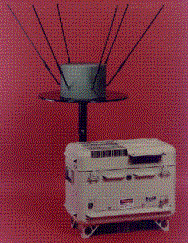



The Shortstop Electronic Protection System (SEPS) is an RF Proximity Fuze counter measure. The Shortstop battlefield electronic countermeasures system is capable of prematurely detonating incoming artillery and mortar rounds. It counters the threat of RF Proximity Fuzed munitions by causing them to prefunction, to protect friendly ground troops, vehicles, structures, and other equipment under fire.
The SHORTSTOP system was originally produced as a Quick Reaction Capability (QRC) product in support of Desert Storm. A request for information (RFI) was received from ARCENT addressing available countermeasures for indirect fire munitions utilizing proximity fuzes; such as those found in artillery, mortar, and rocket munitions. Whittaker Corp. in Simi Valley, CA built the system for PEO-IEW during the Gulf War in response to the artillery threat posed by the Iraqis, but the war ended before Shortstop could be deployed. The system could reduce casualties to ground troops by as much as 50 percent during the initial stages of an enemy attack.
These prototype systems were subjected to a minimal amount of environmental testing in preparation for deployment. After Desert Storm, the system was subjected to extensive live fire testing in the desert at Yuma Proving Grounds and evaluated by the TRADOC Analysis Command (TRAC) and the Dismounted Battlespace Battle Lab. The SHORTSTOP, AN/VLQ -9 or -10, systems demonstrated, in testing, the ability to significantly enhance survivability of troops and high value assets from indirect fire, proximity fuzed munitions. Reports of more than 5,000 live artillery and mortar round firings against Shortstop in tests at Yuma Proving Ground, Ariz., indicate that the system is 100 percent effective against selected weapons. The test rounds were fired singly and in barrages, with none reaching their intended target, test officials reported.
The prototypes were deployed for a limited period of time in Bosnia and were returned to contingency stock in 1997. To meet urgent operational requirements for deployed forces, the 3rd Army Commander on 11 Feb 98 requested 12 Shortstop Electronic Countermeasure Systems. These systems were readily available as a near term loan that only required funding to train operators and purchase some fielding and maintenance related items. HQDA approved the release for immediate deployment, requesting AMC execute the action that was subsequently completed by CECOM's Project Manager for Firefinder. The QRO supported delivery and fielding of these systems by coordinating the necessary arrangements for deployment of a two-man New Equipment Training Team (NETT) from CECOM. The NETT departed on 25 Feb 1998 with the equipment (acting as couriers) on a C-5 Cargo flight out of Dover AFB. The SHORTSTOP system training, checkout and positioning was completed by the CECOM NETT 20 March 1998.On August 27, 1999 Condor Systems was awarded a $8,513,414 (base year total) contract as part of a $25,000,000 (total if all options are exercised) firm-fixed-price and time and materials contract for 40 Shortstop Electronic Protection Systems (SEPS). Work will be performed in Simi Valley, Calif., and was expected to be completed by Dec. 31, 2001.
Packaged in a suitcase-size case and fitted with a small multi-directional antenna, the Shortstop system can be activated and operational within seconds. Shortstop's passive electronics and operational features make it impervious to detection by enemy signal-intelligence sensors. In the near future, Shortstop will shrink in size, down to 25 pounds. Whittaker is currently under contract to build three new, smaller versions: manpack and vehicle units, as well as a stand-alone unit.
